Episodes
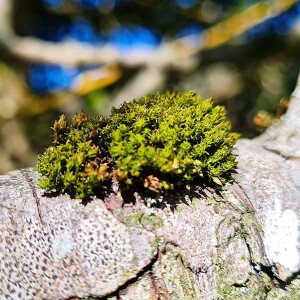
4 days ago
4 days ago
A bright April day has dawned in Derbyshire earlier in the spring. The air is unusually still for this time of year and this upland location. At just under a thousand feet barely a breeze is ruffling the trees surrounding the mics. These are the same trees that can be heard so powerfully in episode 250 - Moorland trees in mid-winter gales.
Far across the valley, stretching from far left to far right of scene, a country road threads its way over the moors. It links the small Derbyshire town of Whaley Bridge to the busier Cheshire town of Macclesfield about seven miles away. Due to a major land slip and road closure on the next valley, there is less traffic, though you can hear occasional cars threading the tarmac way through the landscape from time to time.
Mid left down the field, a woodpecker. In the same copse, a song thrush. From different points in the mid-distance seesawing great tits. Wrens too, and wood pigeons, and a chif chaf, and a pheasant. Deep in the valley, geese can be heard over the reservoir. What made this segment of the overnight recording feel special though was the blackbird.
As time passes the blackbird lands on a branch of the apple tree directly above the Lento box, and sings so sonorously. And then does it again, as if it knows how special it is to witness a singing blackbird so close.
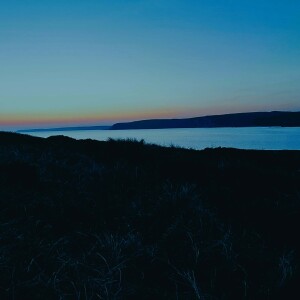
Thursday Jul 03, 2025
274 Burgh Island midnight tide (sleep safe)
Thursday Jul 03, 2025
Thursday Jul 03, 2025
(pronounced Birr Island)
This long, slow Devon day, is drawing softly to a close. Looking out to sea, the sky beyond has already fallen velvet black. It's midnight. Scattered lamps shine on Burgh Island. It looks from here more like a dark thicket, afloat on a vast water field. With glow worms, hiding.
The tide's in now. Closed around the island. Encircled it, with rich undulating sound. Filled up the wide sandy beach, for as far as the eye can see, with swirling shallows. Ankle deep. As the sea meets itself coming in across the causeway, it splashes up fingers of crisp white spray.
Some gulls are still aloft. High wheeling, but mostly quiet. Silently weaving between the stars. Riding on the diurnal winds. the off-shore breeze, or land breeze, created by the land-sea temperature contrast that happens at this time of night.
* As with all Lento episodes it can take several minutes for your listening brain to properly switch into the soundscape. This one hour segment is from an overnight recording we made in April. The Lento box is perched on a second floor balcony looking straight down the causeway towards Burgh island, which is only about 200 yards from the box. Due to the topography of the beach and how it contours around the island, the sound-shape of the sea is interestingly different to other coastal locations we've captured. The breakers form and gather spatially, often very slowly, with long periods of swirling eddies in between. High tide is reached towards the end of this segment. Moderately strong wind gusts sometimes buffer the microphones. As a recording location it is exposed. We've applied some spot rumble reduction when this happens just to improve the experience for headphone / Airpod listeners.
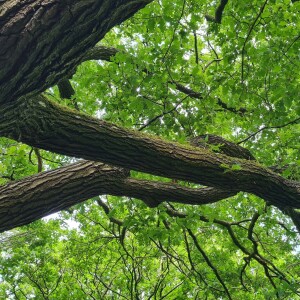
Wednesday Jun 25, 2025
273 Sunset fields and oak trees - spring in Shropshire
Wednesday Jun 25, 2025
Wednesday Jun 25, 2025
Oak trees have a very particular sound this time of year. It's to do with the leaves. Their texture, shape and contours. How they catch and filter the breeze. On a warm spring day, like this one the Lento box captured last month in rural Shropshire, you can hear the softness of the moving air sonified by banks of oak leaves.
The scene around the microphone box, tied to the trunk of a relatively young oak tree, is endlessly rural. Ahead, over a bank thick with tangled shrubs, a wide field, vibrant green, is dotted with sheep and lambs. Song birds sing out from around the small nature reserve. A place called Poles Coppice. A point on the landscape with many neatly hidden well occupied perches. Birds are like nothing else. Their songs illuminate dusky shadows between the trees. And carry far. Over fields, bathed in late afternoon sun. And sheep, dutifully grazing
* Poles Coppice nature reserve is quite remote and has a lovely sound-feel, thanks to its resident birds and oak trees. the country road that can sometimes be heard mid-left of scene (far distant) leads to a small town called Minsterley. When that day last month we set out to capture the spring sound of Shropshire we auditioned various locations before eventually stumbling upon this particularly peaceful little place. Thank you to the guardians of Poles Coppice who created this nature reserve. We are so glad to be able to share its natural sound.
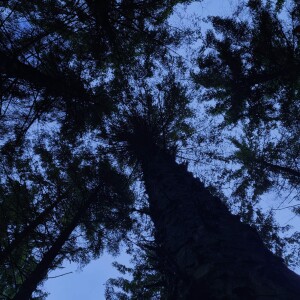
Monday Jun 16, 2025
272 Emptiness within Shelve Wood at night (sleep safe)
Monday Jun 16, 2025
Monday Jun 16, 2025
Experiencing the spatial sense of emptiness, in a natural place, when there's nobody about, endlessly fascinates us. We built a high resolution immersive sound capture device to study it. We find natural places to leave it out recording alone, to capture quiet scenes in sound. Of time passing.
We are all intrinsically hyper-attentive to the possible presence of people within our surroundings. Any movement that might signal another person in the vicinity, fundamentally changes our thoughts. It deflects our mind's eye from fully connecting with the place. This is why we always set out to record in largely uninhabited locations that are good sources of naturally occurring sound.
Before Lento came about, the question of whether or not a falling tree makes a sound when there's no one around to hear it, proved puzzlingly difficult to argue in classroom discussions. If only we could send back in time this sound-scene of Shelve Wood in Shropshire, that we recorded last month. Yes, remote listening is a thing. Be there and yet not be there to hear the trees. Slow banks of shifting air, brushing softly, panoramically, through the firs. And every drop of rain, that finds its way down, between the branches, to land on the soft dry carpet of the forest floor. Shelve Wood has an acoustic that conveys space. A vast space. It is a space that, especially at night, murmerates with deep, velvety echoes. Hushes. Thousands of conifers and spruce, moving together, in natural sympathy with the wind.
* This section of time is from a 12-hour overnight recording we made last month in beautiful Shropshire. The fir tree that held the Lento box was impressively tall, and peaceful.
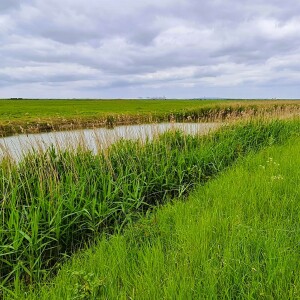
Wednesday Jun 04, 2025
271 Wild breezes in the reeds - spring along the Thames Estuary
Wednesday Jun 04, 2025
Wednesday Jun 04, 2025
This soundscene was captured two weeks ago from a rackety wooden fence beside a grass meadow. Reeds are growing to right of scene, waving and hushing in strong gusts of spring warm wind. Centre, a view out across the meadow. Left of scene, over a rough track and an overgrown strip of marshy land is the Thames Estuary. Above, from time to time, skylarks. Hidden not too far off in a thicket, a cetti's warbler. Various other birds come by, each a pleasure to hear, with its own unique estuary sound.
It's a scene that feels wide open and exposed. It's lashed by the weather. Strong gusts and breezes, and quick whispering winds. But being the end of May, it's warm. The sun is radiant. Its energy heats the ground, creating deliciously warm sweetly scented banks of moving air. Thermals, that the birds use to rise easily into the sky. The Thames, at this point sprawling wide as a lake, provides navigation not just for ships but for aircraft. Fortunately only a few pass over during the time of our recording. This is what nature along the Thames Estuary, from a rackety fence wobbling in the wind, really sounds like.
* Thanks again to Lento supporter Ian for taking a day to drive us and the Lento box out to the Thames Estuary. Getting to remote locations so we can capture and share the sound-feel of being there is what Lento is all about. And it ought to be quite a straightforward process. Check map for a nice looking location. Travel out to it with recording gear. Set up, press record, wait about for around an hour, then return home, listen to the captured soundscape and publish! The weird thing is despite having recorded at over a hundred different physical locations, we still haven't quite worked out how to persuade birds to sing on cue, wind not to gust out of control, rain to fall just when we want it, and cars planes and people to vacate the area while we are recording...
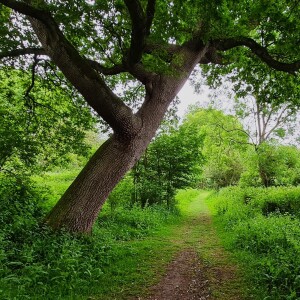
Monday May 26, 2025
270 Soundscene from Northward Hill Nature Reserve featuring a nightingale
Monday May 26, 2025
Monday May 26, 2025
Whilst out along the Kent side of the Thames Estuary on Saturday, aiming to capture the sound of skylarks and reeds, we met a walker with a very friendly border terrier. She told us there was talk of a nightingale not too far away at RSPB's Northward Hill Nature Reserve. We aren't strictly speaking wildlife recordists, the Lento box is designed like a wide angle camera to capture panoramic landscape sounds, but we thought it might be worth a visit to the reserve to see if we might be able to find it.
Unusually for us public transport devotees, we were able to travel on to Northward Hill easily thanks to a magnificent Lento supporter. He'd driven us and the Lento box out from Brockley station in South East London to explore another corner of the Hoo Peninsula, and was keen to visit the reserve. We didn't feel hugely confident about actually hearing a nightingale. They are the kinds of birds you don't expect to find on demand.
We rolled into the reserve's car park and quickly headed down into the woodland. We descended a rough flight of bare earth steps under the dark shadows of dense tree canopy, surrounded by glorious birdsong. All the usual suspects of course, familiar if you regularly listen to Lento - chif chaf, blackbirds, black caps, jackdaws, robins, various others plus trusty wood pigeons.
After turning right and proceeding further into the woods over a few hundred yards our ears pricked up. I found myself saying "and there it is" before I had even properly heard it. We continued for a few steps and, fortunately, there it was again, this time much more clearly, and without doubt a nightingale only about thirty yards away! Up on the tripod went the Lento box. I turned it to face the sound of the nightingale, and pressed record, bathed in the rich tapestry of spring woodland birds, coming from all around us.
Here's what the box captured. It's only twenty minutes. The passage of time is from around 5pm on 24th May. There are some people vaguely audible and a horse (louder) somewhere to left of scene. A road must pass the reserve too because some level of vehicle noise is distantly audible, but not so much as to spoil the overall effect. We capture whole landscapes from one fixed position, so what you hear is the nightingale just as we heard it from standing on the path and facing into the reserve. Wildlife recordists find ways to post their microphones very close to their subjects and as such we are all used to hearing nightingales proportionately far louder than anything else. In reality though these are not birds that like being approached, so few people can ever actually hear in-person, the bird singing as loudly as they do in specially focused recordings.
With a pair of headphones though this episode provides a realistic woodland soundscape with a nightingale almost dead centre of scene. You should be able quite easily to hear it between the other birds which are spread out to the left and to the right of scene. Listen out for a wonderfully special coincidence that happens a few times where a distant cuckoo comes into earshot too. It is pretty well dead centre, behind the nightingale.
There must be a farm nearby because several cockerels crow towards the end. The whole scene is in fact very busy, and whether a connection or not, I note how the nightingale seems to become more active when the chif chaf is in full voice. Coincidence, or not?
This bonus episode is shared with big thanks to our trusty supporter and to the dog walker we met.
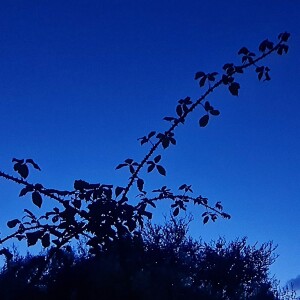
Saturday May 24, 2025
269 Night crickets distant waves - Folkestone Warren (sleep safe)
Saturday May 24, 2025
Saturday May 24, 2025
At this spot, high up on The Warren, in the dead of night, live the crickets. They're everywhere. Stridulating, like tiny minute hands etching the moments, of this night's time passing. Crisp. Unwitnessed. They're probably dark bush crickets.
The Lento box records the scene alone, on a warm night last August. Tied to a very difficult tree. Difficult because it was very spiny. And off the path, part way down a precipitous drop. Why not an easier tree? Because of the view. This tree looks out over the valley, over all the tree tops, towards the hushing sea, far below.
Time passes. Somewhere in the valley, an ocean breeze lows in. Shifts a bank of trees into a state of gentle rustling. Countless crickets mark the moments. Then from nowhere a nocturnal train materialises in the bottom of the valley, right of scene. It glides across, and into the left horizon. Further and further. Until finally, it dissolves, and becomes just another part of this place's subtle, and natural murmurings. Perhaps a hedgehog is moving in the bushes. And a hint of a plane, heading south east towards France.
* This 50 minute section is from a 48 hour recording we made in Folkestone Warren last August. It captures a deeply peaceful scene of this green and tangled place, by the sea, and the endlessly breaking waves of the Channel. Listen carefully (with headphones or airpods) and you may catch sound of a lower pitched cricket to left of scene. We still aren't sure what exactly it is, but it sounds like the cicadas in old films from 1950s America.
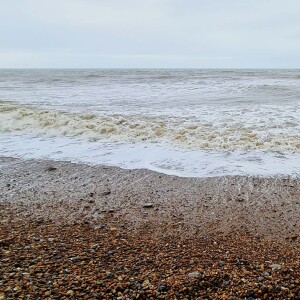
Thursday May 15, 2025
268 A wild ocean above ancient tree stumps
Thursday May 15, 2025
Thursday May 15, 2025
Pett in Sussex. A 'small peaceful seaside village'. Here you can visit a little timber chapel on the beach with an open door to a kitchen. You can take a seat, absorb the atmosphere, then make yourself a cup of tea if you like, choose a book from the shelves and drop your donation into the honesty box. Before heading out to explore the wild pebble beach, crashing waves and sea defences. All perfect for blowing away the cobwebs.
But this is one of those places that makes you think too. Yes there's the village, the chapel, the wonderfully exposed coast path and beach, but there are other significant things too. Things that make the past resonate.
The end of the Royal Military Canal culminates here. A 28 mile inland channel linking Pett Level to Hythe. It was built as a defence against the possible invasion by Napoleon. Above on the hill a pillbox, a relic from WWII, looking out to sea.
Back more. Back and back. Far into the mists of time. Not old history, not human history. Ancient history. The Pleistocene. Before the last ice age when there were no humans about to even know this coastal place exists. Or to witness its wild crashing waves. Dinosaur footprints left in the rock.
At low tide the stumps of ancient trees can be seen. One day we'll travel back at low tide, and hopefully capture the sound of the waves as they break over these ancient stumps of oak, birch and hazel. And as we set up the microphones, we'll imagine ourselves deep in a forest, immersed between hushing trees and echoing birdsong.
--------------
Come with us on a walk on this February day. See the sites around Pett.
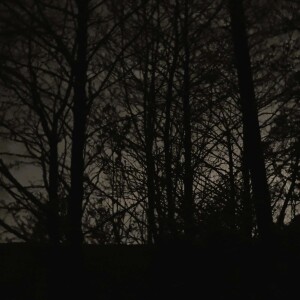
Wednesday May 07, 2025
267 Hidden dell at night (sleep safe)
Wednesday May 07, 2025
Wednesday May 07, 2025
This week we're staying on the uplands of rural Derbyshire to hear a passage of time from the dead of night. We captured it last month, from a location very near to last week's episode,
About half a mile upstream, high above the valley pastures where the sheep live, hides a watery dell. It's shrouded under tangled trees, who no doubt thrive on the plentiful supply of water. An iron age track slopes steeply down before fording the stream. Beyond the stream is an area of dark moorland forest. We've recorded here many times over the years. It's a location that possesses richly varying sound-feels, not just from season to season, but often from hour to hour.
Overflights from aircraft heading into Manchester's Ringway Airport heavily impact the natural soundscape here. To get round this we leave the lento box out recording for very long periods of time. When the flight path moves, the sky clears of human-made noise, and we are able to hear just the natural environment again.
The Lento box records through the quiet hours of the night. Tied to a tree only a few yards from where the track fords the stream. To right of scene a cool pool of moorland water shallows onto stones over which people have crossed with their animals and carts for countless centuries. Centre of scene the stream flows down into another pool, before continuing on its way down into the valley. The trees, now in leaf, create an acoustic space inside which the sound of the stream reflects. Through long listening, the wide spatial presence of the valley beyond can also be heard. Or perhaps we should say felt. Valleys, from an aural perspective, transcend any obvious aural description.
--------------
Please help us keep Lento ad-free - buy us a coffee on Ko-fi.
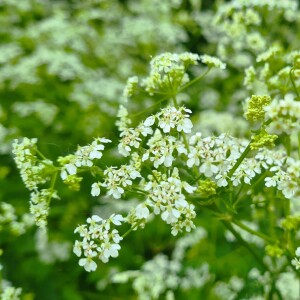
Tuesday Apr 29, 2025
266 On upland pastures
Tuesday Apr 29, 2025
Tuesday Apr 29, 2025
Left of scene, a steep uninhabited valley, shrouded under dense woodland. Right of scene, rough pastures and grass meadows sloping gradually up, towards a distant horizon. Centre, a silvery glimpse of the moorland stream that's flowed down into this valley for as long as rain began to fall.
Spring has arrived. The valley is verdant green, and alive with song birds, sheep and lambs. The air is so still, and soft. The scents of hawthorn and cow parsley rise on sun warmed eddies. Bees, from plant to plant, appear. Then disappear. Then appear again. Hovering. Manoeuvring. Speeding away. A lone goose in the mid-distance, is flying gracefully up the valley. Is following the stream. Its calls echo, across the vast empty space.
How over time the sounds of this valley form naturally into a portrait. A spatial depiction, of life on an upland pasture. Clean. Fresh. Uncluttered. Unconcerned. And it is there. And with headphones, and a bit of time sat still, we can be there too.
* This segment is from a long-form recording we made of this valley several years ago in the Peak District. We visited again only a few weeks ago, we can say things sound very much the same on the ground. What is changing though is an increased intensity of air travel. The skies are noisier now, preventing us from being able to share more recent recordings.
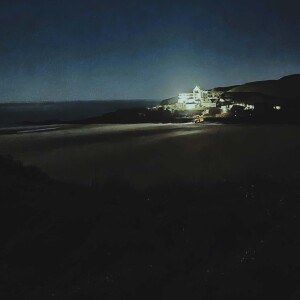
Monday Apr 21, 2025
265 Low tide on the causeway (sleep safe)
Monday Apr 21, 2025
Monday Apr 21, 2025
Last week we visited Burgh Island in Devon on the south west coast of England. We made two overnight recordings, both looking out towards the island from Bigbury-on-Sea. The island is connected to the mainland by a sand causeway. This passage of time is from the second unaccompanied overnight recording, midnight to 1am.
The darkness is solid. A landscape only sparsely inhabited. Low tide was several hours ago, but you can hardly tell that the sea has started to come in. Weather conditions are extremely mild with wind speeds of only 1 to 2 knots, gusting 5 to 6. After the first few minutes, the wind that's been audibly rustling the leaves of the palm tree holding the Lento recording box, drops to virtually nothing.
The stillness reveals an aural expanse of true pristine quiet. The beach, stretching from far left to far right. The sand causeway, directly ahead, leading up onto the island. The sea, a split view with crashing waves audible both on the left side and the right side of scene, with the island a silent space in the middle. It's very rare we discover a landscape that possesses this level of peace. Such quiet enables the most delicate and the most spatial qualities of the aural environment to be perceived. A scene of an island, asleep, between two seas, at low tide.
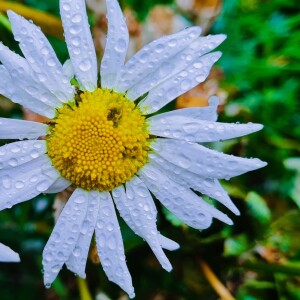
Sunday Apr 13, 2025
264 Garden rain at night (sleep safe)
Sunday Apr 13, 2025
Sunday Apr 13, 2025
Last summer when we were stuck at home, and when heavy rain was forecast between midnight and three, we decided it'd be nice to capture its sound. The idea is enchanting. Rain, falling, on a little suburban garden, verdant with plants and shrubs of various kinds, as they quietly and invisibly sleep through the night.
Hearing this scene though, is only possible by staying up and getting very tired and wet. But this is where the Lento box comes in. By leaving it out all night to do the listening and capturing, in natural spatial detail, we can then re-experience the sound of time passing through a pair of headphones or Airpods. It's a much more comfortable way to appreciate what a place sounded like, when there was no one around to witness it.
If you've listened to Lento before, you'll know we usually capture the sound of falling rain from underneath a large tarpaulin we have stretched across our back yard. This time we decided to try something new. Right at the end of our little garden there are lots of plants and shrubs huddled against an old brick wall. Along the top of the wall is a wisteria plant that's got very big over the years. So many different types of leaves, we thought, to catch the rain drops as they fall. Just before midnight, and as the first rain began to fall, we placed the Lento box on a short tripod directly underneath the wisteria, and left it to record. Water was already pouring down through the leaves. A test for the box's weatherproofing, we hopefully muttered to ourselves, as we closed the back door and shuffled off to bed.
* The recording location was north east London in July 2024. We have carefully chosen a segment of time where the least traffic noise and human activity is audible. Some micro-editing was needed though to ensure unavoidable noises such as heavy raindrops landing directly onto the microphone baffles and the occasional crump of cars rolling over local speed bumps have been softened out. Some planes overfly but they are very soft and gentle in tone. We have tagged this episode sleep safe due to the minimal impact of these non-natural sounds.
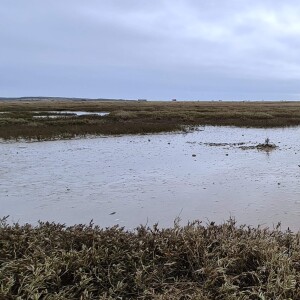
Saturday Mar 29, 2025
263 Wild open coastal reserve
Saturday Mar 29, 2025
Saturday Mar 29, 2025
Sat back, looking onto Rye Harbour nature reserve. There, to the ear, is the sea. From here it's out of sight, somewhere below the long shingle ridge. From this point across the reserve, it could to the ear be an aural sunrise. A wall of natural energy, lighting up the horizon with clean, white, spatialised noise.
On the intervening land, stray gusts of wind swish swathes of sea grasses. Press whispily through thin wire fences. Lift circling seagulls even higher. Billow shapeless banks of cloud, from left to right of the gradually illuminating sky, water and air.
In such an exposed panoramically vast space, come the timeless calls of sea birds. Animated brush strokes on a canvas that stretches from far left, to far right of scene. Each stroke, is an individual. Each, a living thing. A soul, for whom this wild open place is home.
* This early morning hour is from an overnight recording we made last month from the edge of the nature reserve at Rye Harbour, East Sussex. It captures the sound-feel of wide open emptiness that you get when out and about on the reserve. It's also a rich source of naturally spatialised blue-grey and dark grey noise, produced by the sea and shaped by uninterrupted expanses of gently contoured shingled land.
** Lento is 5 today! Happy birthday to us!
Thank you for listening, sharing and supporting us over five years.
More here > https://ko-fi.com/radiolento
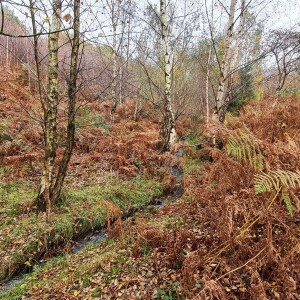
Monday Mar 24, 2025
262 Night stream at West Quantoxhead (sheep sleep safe)
Monday Mar 24, 2025
Monday Mar 24, 2025
We found our way to record this remote location late at night, and in near total darkness. A sheltered dell, with a fresh running stream. Earlier in the day, when everything was bathed in bright grey light, we'd walked through this secluded place on our way down from West Quantoxhead, and decided it might be a perfect spot for the Lento box to make a long overnight recording.
There's a branch just above your right shoulder, my partner quietly calls up from below. Can you use that to lever yourself up? The height I'd just gained had markedly improved the spatial clarity of the wrilling stream, so just a little higher, I thought. We really need to be able to properly hear the full width and detail of the water, as it flows through the dell. How still this place is. How perfectly balanced it sounds, nestled within the wildness of this wide open West Somerset landscape.
To reach the branch I had to work my way through a mass of prickled twigs in the dark while holding the Lento box in one hand. After some not insignificant effort, the branch, and my elbow, connect. I haul up, wedge in, and tie the box onto the trunk. To be sure this spot meets the criteria we've evolved over the years, I try to match my head with the box, and hold completely still. Listening. Absorbing the scene. Slightly adjusting the angle of the mics, so they can capture as much as possible of what it is I'm actually hearing. Good, I quietly call down, this is it.
We head back to where we are staying, leaving the Lento box to record alone, non-stop through the night. Without us or indeed anyone else about to witness, time passes. Looking down from the tree, the stream wrills, and the landscape murmurs its nocturnal murmurings. Sheep can be heard, sometimes moving vaguely, through the dark. And one seems to come to rest beneath the tree holding the mics. From time to time it makes the softest, most gentle noise, that a sheep can surely make.
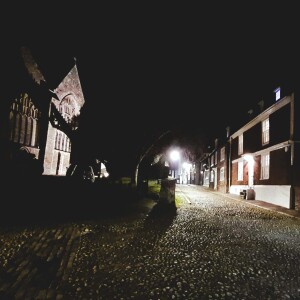
Monday Mar 17, 2025
261 Midnight in Rye
Monday Mar 17, 2025
Monday Mar 17, 2025
Twelve strikes the clock, of St Mary's Church in Rye, East Sussex. Midnight. A sound that for anyone left awake, opens a new page. It's a new day, captured by the Lento box perched high above the churchyard, one night in mid-February.
The new day reads like this. The gnarled limb of a winter tree beside the churchyard creaks against an undulating wind. The flagpole at the top of the belfry tower, rattles, like the mast of some windswept sailing ship.
The sky is heavy with cloud and dark. Coastal air ruffles and catches in the rooftops of huddled 14th century cottages. They look gathered in around the church, like a solid congregation. Time passes. Banks of wind rise, then subside. Creaks and rattles punctuate the night air. And the Quarterboy faintly chime out the quarters.
St Mary's has a good clean bell. It echoes off the huddled houses beautifully. Sonorous tones, that seem to ring out with the same golden grey hues of the stones from which this ancient coastal town is built. The skittering leaves blowing and the almost too faint silvery ding dongs of the Quarterboys.
* We captured this sound-view of St Mary's Church Rye last month on a freezing cold windswept night. We rested the Lento box on the outer ledge of a second floor window that looked over the churchyard and straight at the church itself (with a chain to stop it falling). Do let us know if you can hear the quarters being struck, they are subtle but just about audible.
** Explore more from Rye. Listen to the sound inside the belfry in episode 200. That was a windy night too.
*** We're building up to our 5th birthday. Watch this space!

